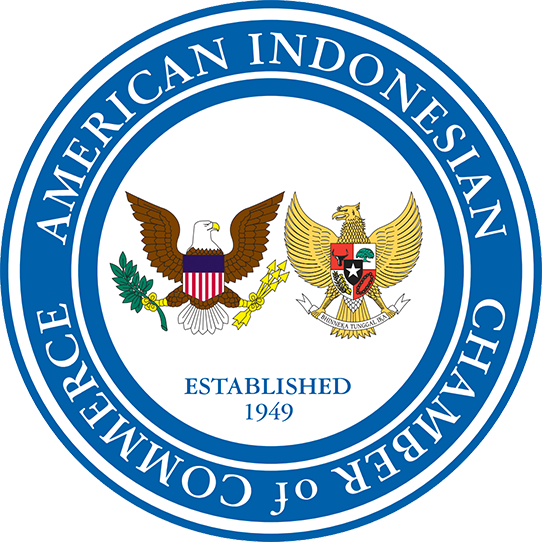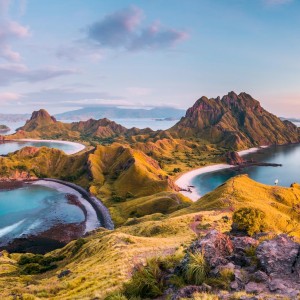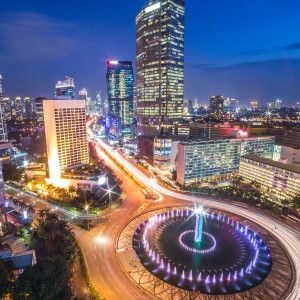| Commentary by Wayne Forrest
It was wonderful to be in Indonesia for two weeks in August for the first time in three years. Not only did I see old friends and make new ones, I had a chance to travel on one of the many new toll roads that are changing the face of the world’s fourth largest nation. It is clear that Indonesia has made big strides recovering from the pandemic, but major challenges remain. Click here to view a gallery of photos from my visit.
My observations:
- Ease of entry– Indonesia only requires proof of COVID vaccination to enter which is facilitated by downloading a Health App to a mobile phone: “Peduli Lindunggi”. Digital images of COVID vaccination cards and other information can be uploaded prior to leaving home. Otherwise, it’s a long line at the airport to show the cards manually. Peduli Lindunggi is required to enter many government offices. In my case, since I was meeting ministers, I also had to get a rapid antigen test 24 hours before my appointment. These test results, available at many locations, are uploaded to the Peduli application within a few hours. Visas are obtained at the airport upon arrival, and you must pay the $35 fee in cash.
- Toll Road Experience- Since President Jokowi assumed office in 2014 his main priority has been infrastructure, specifically toll roads, and unlike his predecessors he has succeeded in building hundreds of miles of them. Since I had a few days of meetings in the central Java city Yogyakarta, I arranged, with the help of Harry Lim, an AICC board member based in Indonesia, to drive back to Jakarta. In 2010 I was in Yogyakarta and my flight back to Jakarta (to attend the State dinner for President Obama) was canceled when Mount Merapi erupted. My only choice was to borrow a car and driver and the trip took 16 hours. This year it took 7. The road was busy with trucks. When I met Jokowi in 2005 when he as mayor of Solo, he told me a toll road to Semarang was his main wish from the central government. The ex-furniture maker knew what he wanted, and he had to become President to get it.
- Politics- I had expected more political conversations, given that the media is actively covering the emerging coalition building that typically occurs prior to national elections. However, although Gerindra has chosen perennial candidate Prabowo Subianto as its candidate, no other parties (or groups of parties) have formally announced. Polls are proliferating and with them rumors of alliances. With the election scheduled in February 2024 its just too early to say anything definitive. Besides, most Indonesians are focused on economic recovery, inflation, and the G20. However, most political parties remain dependent on family dynasties or oligarchic partnerships with few defined by issues or ideology. Perhaps a new dynamic will emerge.
- Energy Subsidies– I was in Indonesia August 1-14 and not a day passed without press coverage of the ballooning cost of gasoline subsidies. Indonesia is a net importer of oil/gas. The most consequential statements came from Finance Minister, Sri Mulyani, who artfully found a way to criticize the subsidies, pointing out that the biggest beneficiaries are the middle and upper class. Her comments foreshadowed what happened on September 2 when the President finalized a decision to cut them back, raising prices 30%. Predictably, protests have erupted. The government, according to most editorials and economists, was in a tough position and had to act.
- Inflation Now and Ahead: Although Indonesia’s rate of inflation is around 5%, it is due to rise with the 30% rise in fuel costs. The central bank has already raised interest rates, in part to continue Indonesia’s ability to attract fixed income investments but also to guard against an overheated economy. However, the welcome GDP rebound experienced in the year to date could slow in the months ahead.
- Emblematic Police Investigation: Big news while I was in Indonesia was the ongoing investigation of the cover up of a murder of a police officer allegedly by other members of the force led by an Inspector General. The incident sullies the reputation of the police who are notorious for their attachments to illegal gambling and other corrupt pursuits. However, many I spoke to are looking to the bright side, the story could lead to long overdue reforms.
- PPE Donation: A highlight of my visit was meeting the two officials who facilitated the distribution of NY City’s surplus COVID medical supplies, Harjawan (BUMN) and Dini from the military. Delivered from July-December 2021 over 250 tons of ventilators, protection gowns, syringes, gloves, testing kits, and masks have now made their way to public hospitals in the country. I was given two awards to take home: one for AICC and one for NY City.
- Monetizing primary forests: I spent several days assisting a delegation of AICC members who import a leaf from Indonesia, kratom. Kratom trees grow wild in Indonesia’s rain forests and river basins. After processing in the US, they are sold as teas or capsules, effective as mild mood enhancers and pain relievers. Led by Mac Haddow, Senior Fellow on Public Policy at the American Kratom Association, the group included a leading Johns Hopkins Medical School and National Institute on Drug Abuse kratom researcher, Dr. Jack Hennigfield; a Utah State Senator who authored the nation’s first consumer protection legislation, Curt Bramble. Our message: Indonesia employs over 200,000 kratom farmers and pickers that service 11 to 15 million US consumers. Ongoing anecdotal and laboratory research shows the safety of the product. Shipments are estimated to be 2,000 metric tons monthly and $1 billion annual retail sales. Like other herbal products originating in the rain forest, such as quinine (anti-malarial), captopril (heart failure), and periwinkle (leukemia), kratom deserve more research as a natural analgesic as it appears not to have debilitating effects of addictive opioids. By developing the kratom industry Indonesia can hold off rain forest destruction. At just about every meeting the Ministers we met committed to the principles contained in a groundbreaking MOU developed by the AKA and several farmers cooperatives: safe and pure product, fair price for farmers, revenue for the government.
- US Soft Power: Although authoritarian governments such as China or the UAE grab headlines with big ticket investments in infrastructure, whether directly to projects such as the Jakarta-Bandung High Speed Railway or indirectly in Indonesia’s Sovereign Wealth Fund, these regimes hold little that Indonesians aspire to. US consumer products, architecture and design, education, fashion, sports, films, TV, music, and dance continue to fascinate Indonesians. Indonesian blues bands are proliferating, students want to study in the US, and Starbucks coffee shops take pride of place in the rest stops along the new toll roads.
- Resource Nationalism: I observed no retreat from Indonesia’s controversial policy to ban the export of mining raw materials. President Jokowi highlighted the strong numbers of stainless steel exports (based on nickel) in his annual independence day address and said that soon other minerals such as bauxite would also be banned.
- Whats App: My visit confirms what I have been suspecting for some time: the messaging application What’s App is now the dominant communications medium, more so than email. Business and government leaders, including ministers, freely communicate this way and will give you their mobile number or that of a close assistant.
- PIK– Indonesia 30 years in the future can be glimpsed along the seacoast north of downtown Jakarta. Still part of the city, it is a region all to itself, a modern planned city, much of it built on land reclaimed from the Java Sea. I first heard about Pantai Indah Kapuk(PIK) in the late 1990’s when AICC member Development Design Group (DDG) created PIK’s master plan for the real estate developer Ciputra. The mixed-use design of single-family homes, high rises, parks, golf courses, hotels, office complexes, and shopping districts is now a reality and PIKs 2-4 are in the works in an overall area almost as large as Singapore. Free of traffic and increasingly bicycle friendly, it has its own Trek store, the PIK region doesn’t flood. As businesses relocate, it will increasingly become a self-contained home/work environment. Much of the investment to build PIK originates in China.
Click Here to View a Gallery of Images from my visit. |





